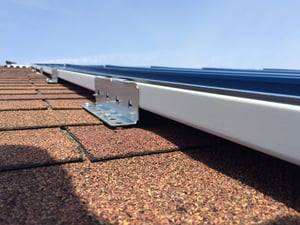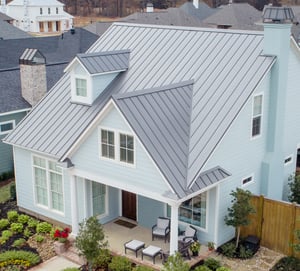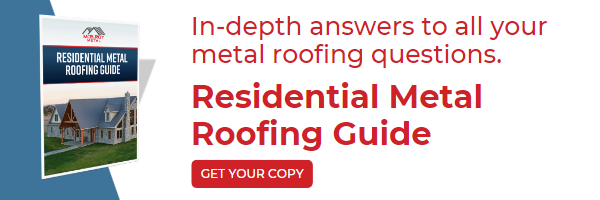Remove and Replace or Recover - Which type of metal roof is best?
So you’re considering a metal roof for your home. Congrats-even if you decide it’s not the time for a metal roof right now, there’s no harm in exploring options! Ultimately, researching a significant home expense like roofing is a smart move.
Your research will likely show that metal roofing is a long-lasting (50+ years of service life) and durable solution. And if the life expectancy isn’t enough, metal roofing also requires much less maintenance. Consequently, it’s an excellent investment for residential homes compared to conventional shingles.
But, if you’re like most folks, you also have lots of questions as you consider metal roofing. Two of the most common we hear are:
- How much will metal roofing cost compared to shingles? You can read more about that by reading our earlier post here.
- Do the shingles need to be removed, or can you install metal roofing over the top of the existing roof? When new metal panels cover an existing shingle roof, it is considered a recover project. And not only is it possible, the recover approach is actually more common than removing the shingles before installing a metal roof. Let’s explore why it’s more prevalent.
 Five Benefits of a Residential Metal Roof Recover
Five Benefits of a Residential Metal Roof Recover
1. Reduced Cost. One of the biggest reasons for leaving a shingle roof in place under a new metal roof involves saving money. When using the recover approach (compared to remove and replace), homeowners save the cost of shingle tear-off and disposal. And who doesn’t love saving money?
2. Peace of Mind. Many homeowners often cite peace of mind as a reason for leaving the original roof in place. Since residential re-roofing projects install pretty quickly, the risk for water intrusion is fairly small, but unexpected storms do happen. With the old roof removed, there’s very little protection until the new roof gets installed. Further, should there be a leak down the road, leaving the existing roof in place provides an extra layer of protection.
3. Less interruption. Removing a roof is a messy, noisy process. Keeping the old roof in place minimizes the mess, noise and shortens the length of the overall re-roofing process.
4. Reduced Electrical Bills. Depending on the install method, metal roofing installed over shingles can reduce electrical consumption by 10-25%. This savings occurs when an air space, commonly referred to as “above sheathing ventilation,” exists between the old and new roof and is adequately vented. While there are several ways to accomplish this cavity, our 138T Shingle Recover System does so without the cost and additional labor of installing furring strips.
5. Recyclability. In addition to their short service life, asphalt shingles are also not an environmentally friendly roofing material. Eleven million tons of shingles are removed every year from existing projects, and it takes 300 years for them to decompose. Consequently, many local landfills charge exorbitant fees to discard shingles.
Conversely, metal roofing is made from a high percentage of recycled material and is 100% recyclable at the end of its service life. So if you’re concerned with preserving the environment for your kids, grandkids, nieces, or nephews, leaving your existing shingle roof in place and recovering with metal can be a great option.
Bottom line: If you’re looking for the quickest and least expensive way to install a metal roof on your home, leaving the existing shingles in place is likely your best approach.
The vast majority of homeowners do just that and have no issues. But of course, nothing in life is guaranteed.
Potential issues with installing a metal roof over shingles
There are some risks involved with leaving an existing shingle roof in place and covering it with metal. Let’s take a closer look at what they are so you can decide whether a complete roof replacement makes more sense for your unique situation.
Trapped Moisture. If water gets trapped between your new metal roof and old shingle roof, moisture can accumulate. Trapped moisture can lead to rot and mold. To avoid this problem, contractors can install venting at the ridge and eave or install the new metal panels over furring strips to raise the metal and create the necessary ventilation.
Unknown Damage. When you install a new metal roof over old shingles, you may miss some severe areas of damage hiding under shingles. Some of this existing damage may be mold, rot, or water spots. If you’re facing issues like warped or uneven roof-lines and broken or rotted components, you would be better served to tear off and repair the issues before proceeding with a new metal roof. Conditions such as these may worsen over time and force you to remove the new metal roof at some point so you can resolve the underlying problems from the old roof.
Building Code Issues. Depending on where you live, you may have to tear off your old roof before installing a new shingle or metal roof. Some jurisdictions require the removal of old roofing before the installation of new roofing. Other areas will allow 1 or 2 layers to remain. It’s important to research local codes before proceeding with recover. Without taking this vital step, you run the risk of compliance issues and fines.
In summary, while most homeowners opt for leaving their existing shingle roof in place, there are certainly some considerations. If you’d like to explore this topic further, check out this recent white paper published by the Metal Construction Association, or visit the Find a Contractor section on our website and get connected to a local professional.
Residential Metal Roof Options
Once you decide whether to remove your shingles or recover them with a new metal roof, you’re ready to determine what style of metal roofing you like. Different expectations require different metal panel alternatives. The best choice for your project depends on factors such as performance, desired longevity, and budget.
One of your first considerations will likely be how the panels are attached to the roof deck. Specifically, are they attached with hidden screws (referred to as concealed fastener systems) or screws that are exposed?
To learn more about this, give our earlier post a read.
Once you understand the pros and cons between the two attachment methods and your preferences, you’re ready to visit the Residential Roofing page of our website to see our complete product offering or check out some of our most popular residential products below.
 Concealed Fastener Systems:
Concealed Fastener Systems:
Meridian. If you’re looking for an economical snap-together standing seam panel, our Meridian panel may be just the ticket. Meridian panels are simply attached to the roof deck with pancake head fasteners with no need for clips.
Tilcor Stone Coated Shingle. If you’re looking for the look of asphalt shingles but the durability of metal panels, our Tilcor Stone Coated Shingle might be the perfect fit.
138T. The 138T Shingle Recover System utilizes patented clips to create an Above Sheathing Ventilation (ASV) airspace that helps generate energy savings when installed directly over the existing shingles.
Medallion-Lok. With a 1.75” high seam Medallion-Lok is an excellent choice for larger, custom homes. Medallion-Lok features hidden clips and a snap-together seam which eliminates the need for job site seaming.
 Exposed Fastener Systems
Exposed Fastener Systems
Max-Rib. Max-Rib's low ¾” rib height is an excellent fit for residential roofing applications.
5V. McElroy’s 5V panels are 24" wide and incorporate the classic standing seam design but use an exposed fastener for installation.
Met-Tile. Our Met-Tile product looks like ceramic tile roofing but offers all the benefits of metal roofing.
Thanks for spending a few minutes with us on your journey to research and consider metal roofing. If you still have questions about the process or the problems that come with installing metal roofing over shingles, we encourage you to contact us today. We look forward to hearing from you!
About McElroy Metal
Since 1963, McElroy Metal has served the construction industry with quality products and excellent customer service. The employee-owned components manufacturer is headquartered in Bossier City, La., and has 14 manufacturing facilities across the United States. Quality, service and performance have been the cornerstone of McElroy Metal’s business philosophy and have contributed to the success of the company through the years. As a preferred service provider, these values will continue to be at the forefront of McElroy Metal’s model along with a strong focus on the customer.









Comments on this article:
Scroll down to the bottom to submit a comment and join the conversation. Need help or have a question? Please contact us. Looking for a distributor or contractor? Please click here to get started.